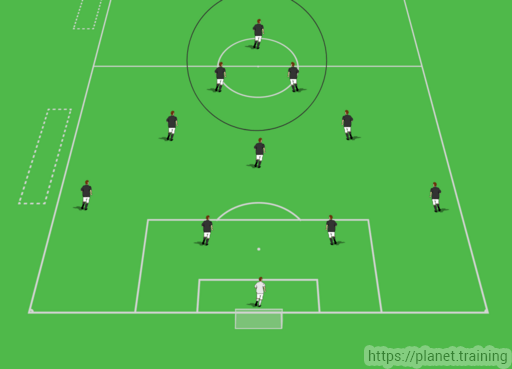WORLD CLASS COACHING
From Rondos to Real Games
By Luca Bertolini
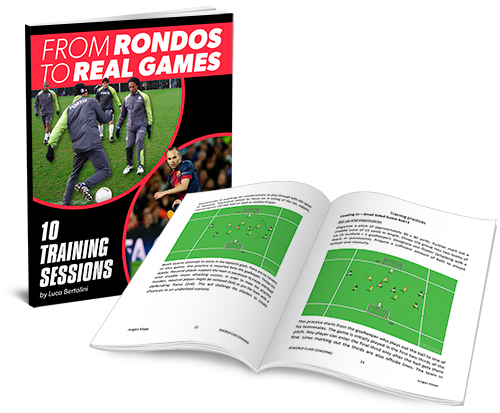
Table of Contents
PART ONE
INTRODUCTION
DEFINITIONS OF SSGs, POSSESSION GAMES, RONDOS, POSITION GAMES
NEUTRAL PLAYERS V COMODINES
PART TWO
TRAINING SESSIONS - BUILD UP FROM THE BACK
PART THREE
TRAINING SESSION - MIDFIELD PLAY
TRAINING SESSION - ATTACKING FROM WIDE
PART FOUR
TRAINING SESSIONS - ATTACKING
Introduction: Small Sided Possession Games, Rondos, Position Games definitions
A small-sided game is a technical exercise performed in the form of a game. The coach, thinking about the goals of the exercise of the training session, shapes and conducts the game based on the number of the available players and of spaces. Small-sided games come from all those games where the number of players, the rules, and the playing spaces must be adapted to perform a match between two teams.
These kinds of exercises are useful to improve players' technical skills and physical conditioning, as the level of effort for the players is very close to 11 v 11 games. Lastly, small-sided games help to motivate those players who isolate themselves and their game vision.
Generally, 4 v 4 and 7 v 7 require the same efforts of 11 v 11 games; 2 v 2 and 5 v 5 are even harder for the players. But, as we found out, there are some important key factors that are responsible for the high intensity performance of a player who is involved in a small-sided game:
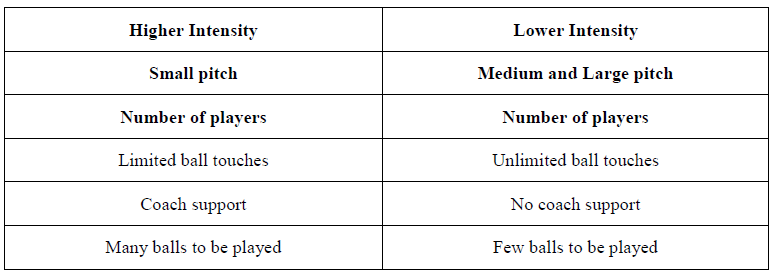
Surely, the sizes of the pitches and the number of players are the key factors producing a high intensity small-sided game. This following table is the most common connection between these key factors:

Small-sided games are reduced versions of soccer games, if we consider it as a sequence of duels with a small number of players. They are limited-the players just work on possession or non-possession phases of play without specific tactical requirements and the transition phases are not coached properly, as they are only a succession of the moves with the ball and without the ball. Just the space concept seems to be a real key point in these exercises.
The tasks of the players need to be specified inside the game and patterns of play need to be created during the game to shape exchanges of positions and rotations of players that they should repeat on the field during the matches. This way, small sided games introduce the timing of play, the numerical advantage, and the outnumbered situations concepts.
There are two fundamental parameters in a soccer game: space and time. The space that the players are given in each situation of the game and the time that they have to fix the issue of the same situation, both from individual and team tactics point of view. The space and the time, while being in possession, and the recovery of the ball, while defending, need to be understood and exploited before the opponents.
During a soccer match there are a lot of "questions" a player must answer quickly (time) and they are related to the measures of the space of play; the ball, the teammates and the opponents give these answers. This relationship of space and time must be coached; they aren't just using simple small-sided games.
Rondos are training games with the numerical advantage for the possession players or team and they are played inside small-sided spaces, usually squares, rectangular or circle shaped spaces.
The main objectives are to keep the ball first of all and then to keep it away from the defenders, playing possession combinations at a high rhythm and speed. The defenders work on pressure timing, closure of the passing lanes, individual duels in the middle of the space and on the recovery of the ball.
Rondos are not simple possession exercises, as the players are placed inside a pre-set space or along a line of the set-up and they don't play all over. It's all about how to keep the possession under pressure, to develop technique and how to put pressure to recover the ball, being outnumbered.
They are useful training methods to develop an advanced possession style of play, much more than simple small-sided games. To keep the possession safe means to play safe passes (forward, backward or sideward); the safest kinds are short passes. But even a short pass must have a purpose.
Here are the biggest differences between the possession small-sided games and the rondos: pass and keep the possession, press and recover the ball with a tactical purpose.
Which are the main types of passes?
" First Line Break/Pass: pass to the teammate next to you. The easiest pass to perform in a rondo as it doesn't require a wide range of vision.
" Second Line Break/Pass: the pass will bypass the teammate next to you but it doesn't split defenders. The second line pass requires a little larger passing vision; it's more difficult than the first line pass.
" Third Line Split Pass: this is the pass that splits the defenders through the middle. It requires skill, creativity, vision and timing of play. In soccer the ultimate goal is to get the ball forward and score. Third line split passes help to develop this skill.
Which are the main types of recovery of the ball when the defenders are outnumbered?
Direct recovery:
" Ball recovery by interception of a pass (a)
" Ball recovery by tackle after a 1 v 1 duel (b)
Indirect recovery:
" Wrong pass due to the closure of the passing lanes (c)
" Wrong pass due to closure of goal or end line spaces (d)
Here's a scheme of the different kinds of pass quality that can be found playing simple possession small-sided games and rondos:
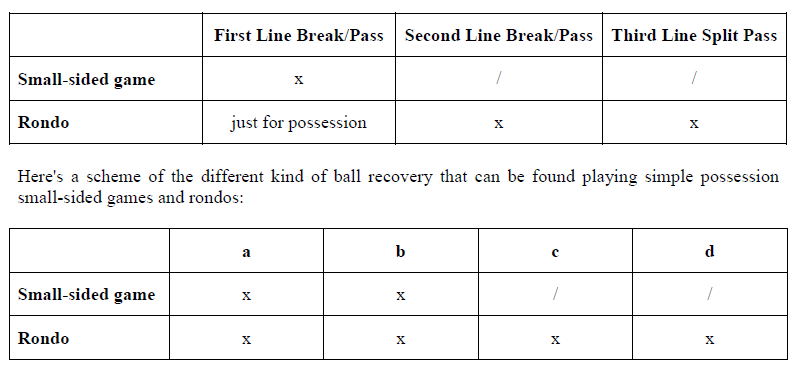
From these schemes, it's clear how rondos introduce the concept of space to be exploited and to be defended.
Anyway, as the numerical advantage is ensured for the players in possession, rondos can be developed in shooting exercises or sequences, as last level of a training progression and moreover in positional games, where the players have their usual role during the matches.
Here are the main differences between possession games and rondos:
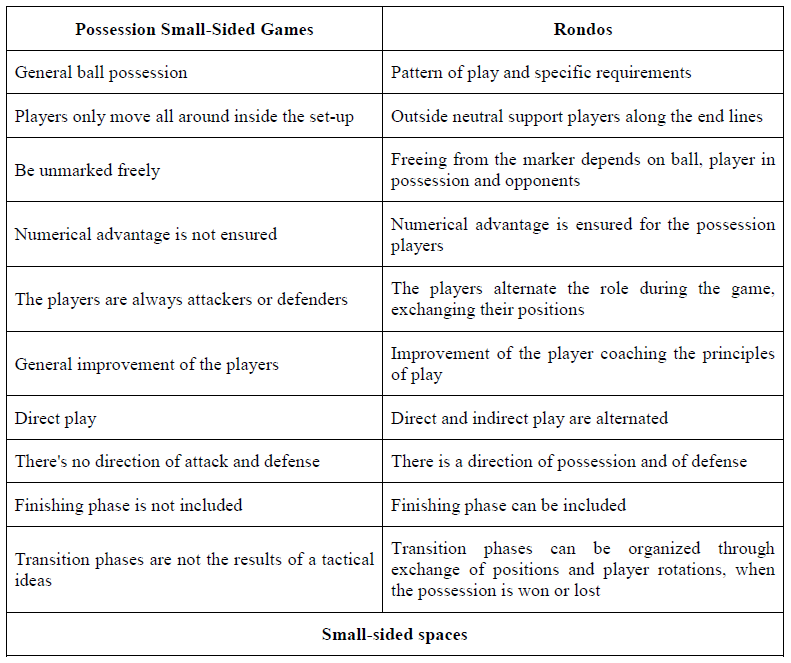
Positional games exercises can be considered possession games, but carried out inside real situations of play, as every player has the same role on the pitch, all the passing lanes are the same of the matches, to free from the marker must be efficient and functional to the system of play.
We can consider the positional games as a direct consequence of rondos and of a modern soccer philosophy with these basic principles of play:
" The goalkeeper builds up from the back
" The outer players run toward the center spaces
" Overload a side and exploit the weak side of the opposition
" Attacking phase is functional to the transition to defend and the defense phases can be efficient
" Defending phase is functional to the transition to attack and the possession phases can be efficient
" Defend forward
" The striker is the space
Positional games include all the components of a training session:
" Technical: all the technical skills of the players are useful to the specific requirements of the coach, of the model and system of play
" Tactical: the player tactical skills are coached inside the "team system," creating the team tactics during the possession or non-possession phases
" Physical: the required efforts of these exercises are specific and based on the roles that the player will have during the matches
" Psychological/Motivation: invite the player to train at their best to play like they would do during the matches
Here are the main differences between possession games and positional games and the only common point:

How should coaches organize positional games? How many players and how many "comodines?" It's very important to be sure that players and comodines together create a team of 10 field players or 11 if goalkeeper is included.
1. The idea must always come from the system of play the team is used to shape on the field
2. The comodines (neutral players) must be positioned first to create the numerical advantage
3. The rest of the players must be divided into two teams
4. The attacking players must complete the team with neutral players; the others are placed inside as defenders
Here is an idea of basic duels with different numbers of comodines:
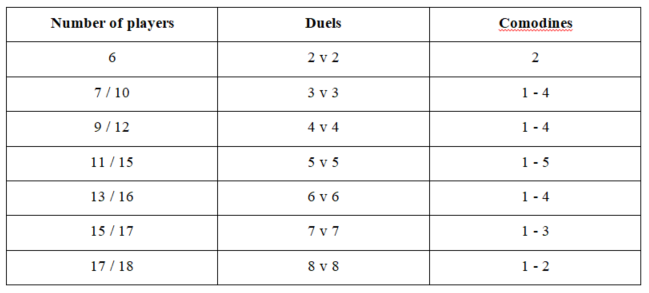
Where to play the positional games? Rectangular spaces and square spaces are the best solutions. Squares are always easier spaces to be understood by the players; but, if a real game situation is needed, then rectangular shapes would be better to create real passing lanes and angles, to make the defending team small and short, overloading the area near the ball and to make it big and wide when in possession, to find the upper vertexes (comodines).
Here is a basic scheme of measures of the pitches related to the number of players. All the coaches should know that the right measures are related to the number, the level of the players and the objectives he is looking for.
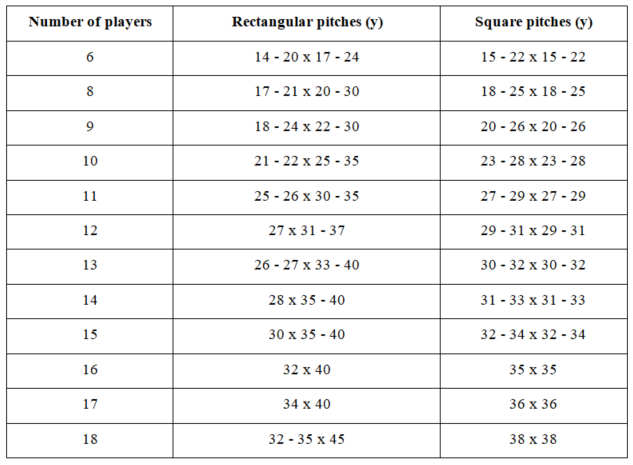
Transition phases are now coached in a real situation the players will face during the matches; both if a team must put pressure, as the possession is lost and if a team must save the possession, playing together with a neutral one, as the possession is recovered. The reactions of the players are now organized and pre-ordered.
Why? Because the possession players are placed in the same positions that are required by the system of play and by the relations among the teammates. The defenders are asked to put pressure, creating a strong area near the ball and overloading it to close the passing lanes and to recover the possession; then, if the possession is recovered, the team must be shaped quickly to save it. Transitions are now coached to be as fast as possible. The positional games can be considered as developments of rondos, but which are the differences and the common points?
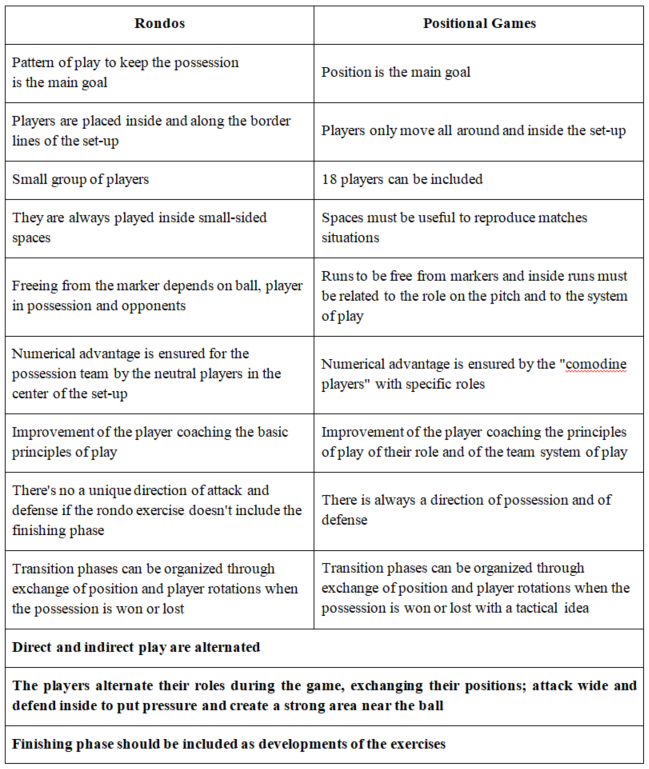
Neutral players v Comodines
The only common point we can find between neutral players and comodines is the creation of numerical advantage for the team in possession. This is an answer to only one question: "what they do?"
How, when, where, why? Let's try answer these further questions.
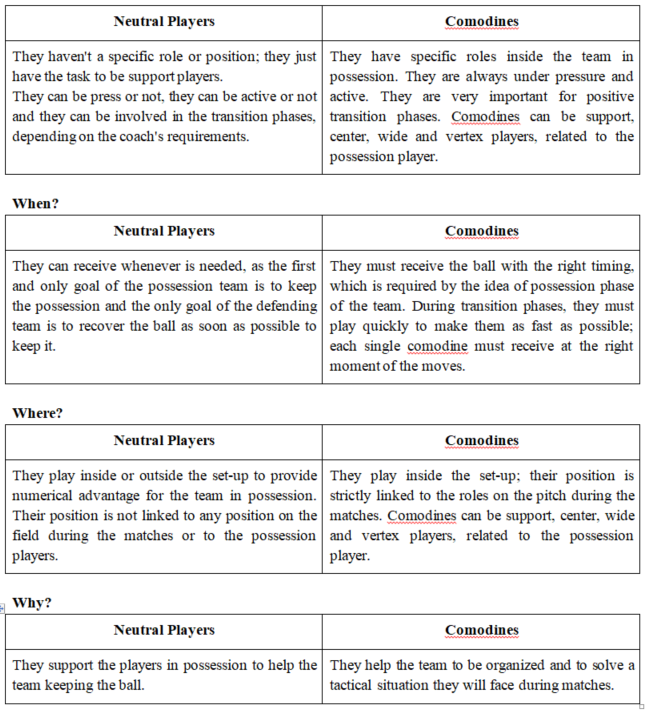
Neutral players

Comodines

How to create a training session?
If we consider possession small-sided games, rondos, and positional games as different but complementary practices, then training sessions maybe organized with these sequences and set-ups:
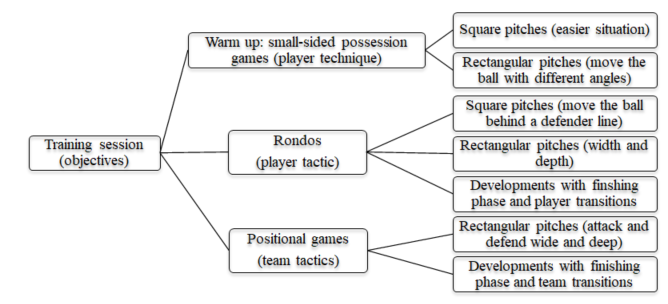
In this e-book, only rectangular pitches are used as set-ups.
Let's now check the coaching points that make all these exercises effective practices, considering four theme areas of a training session:
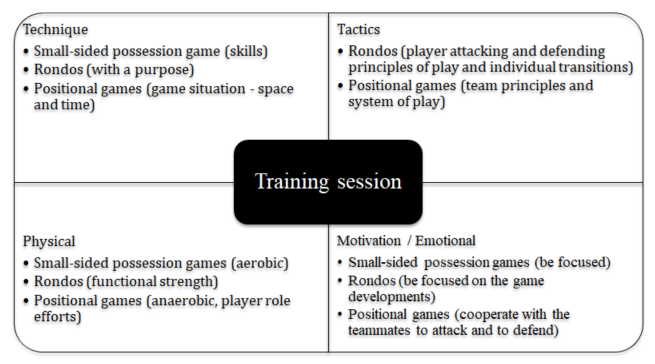
All the training sessions of this e-book are thought as follows: 20 players (18 field players, 2 goalkeepers), one half of a regular field available, one coach, one assistant and a goalkeeper coach. A final free match is always included in all the sessions.
The exercises are planned for 9 or 10 players and the team is always divided into two groups, or three if the goalkeepers work separately.
Every final position game includes a transition to attack/defend phase, if the defenders win the ball; for all the others exercises, transitions phases are change of possession team (small-sided games) and exchange or rotations among the players (rondos).
Systems of play: 1-4-3-3

1-4-3-1-2

1-4-3-2-1
